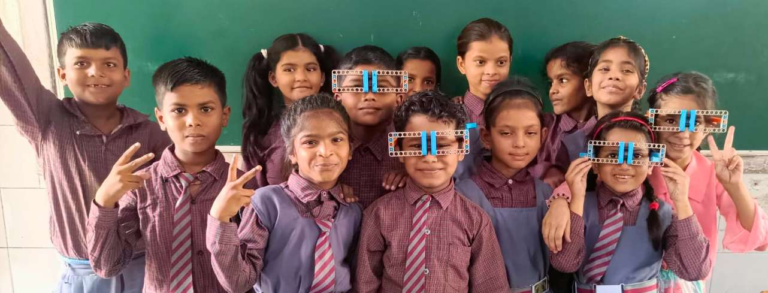Smiles & Giggles Foundation’s Programme called NANHE ENGINEERS , in which we aim to collaborate with MCD schools, believing that introducing robotics and STEM programs in government primary schools will have a profound and lasting impact on the educational and personal development of children.
KEY OBJECTIVES
Enhances Problem-Solving Skills
STEM education encourages students to think critically and approach problems methodically. Engaging in hands-on activities, such as building robots, allows children to experiment, make mistakes, and learn from
them, thereby enhancing their problem solving abilities.
Promotes Creativity and Innovation
STEM programs provide an outlet for children to express their creativity. Through robotics, students can design, build, and program their
creations, which nurtures innovative thinking and fosters a love for exploration & invention.
Builds a Strong Foundation for Future Learning
Early exposure to STEM subjects equips students with fundamental knowledge & skills that are crucial for their future academic and career pursuits. This foundation helps them excel in advanced studies prepares them for a technology-driven world.
Encourages Teamwork and Collaboration
Working on STEM projects often involves group activities, where students collaborate, share ideas & work towards common goals. This experience cultivates teamwork, communication, and interpersonal skills, essential for success in any field.
Improves Academic Performance
Studies have shown that students engaged in STEM education tend to perform better in other academic areas. The skills, confidence gained from STEM activities translate into improved performance in subjects like math, science, and even language arts.
Fosters Interest in STEM Careers
Early exposure to STEM can ignite a lifelong passion for these fields. By engaging in robotics and other STEM activities, children can discover potential career paths, inspiring them to pursue higher education and
careers in science, technology, engineering, and mathematics.


Implementation Methodology for STEM Education
A. Deliver Age-Appropriate Curriculum for Robotics.
1.Foundational Digital Literacy:
Introduction to Computers: Teach the basics of computer hardware and software. Familiarize students with operating systems, file management, and essential software applications.
Internet Safety: Educate students on safe and responsible internet usage, including how to identify trustworthy sources and protect personal information online.
Basic Typing Skills: Develop students’ typing skills to improve their
efficiency in using computers for various tasks.
2.Mechanics:
Basic Principles of Mechanics: Introduce fundamental concepts such as force, motion, and energy. Use simple experiments to illustrate how these principles apply in real-world contexts.
Building Simple Machines: Guide students through constructing basic mechanical devices like levers, pulleys, and gears, helping them
understand the principles of mechanics hands-on.
Introduction to Robotics: Explain the basic components of a robot,
including sensors, actuators, and controllers. Provide examples of how robots are used in different industries.
3. Electricity:
Understanding Electricity: Teach the basics of electricity, including
concepts such as voltage, current, and resistance. Use simple circuits to demonstrate how electricity flows.
Safety with Electricity: Emphasize the importance of safety when working with electrical components. Teach students how to handle batteries, wires, and electrical devices safely.
Hands-On Projects: Involve students in building simple electrical circuits using batteries, wires, bulbs, and switches. This can include projects like creating a basic flashlight or a simple motorized toy.
4.Coding & AI:
Introduction to Coding: Start with block-based coding platforms like
Scratch, which allow students to create programs by dragging and
dropping code blocks. This helps them understand the logic and structure of programming without getting bogged down by syntax.
Basic Programming Concepts: Teach fundamental programming concepts such as loops, conditionals, and variables. Use engaging activities and games to make learning fun and interactive.
Introduction to Artificial Intelligence: Provide a basic overview of AI
concepts such as machine learning and data. Use simple, age-appropriate examples to explain how AI is used in everyday applications.




B. Implementation of Hands-On Learning
Project-Based Learning: Emphasize hands-on, project-based learning where students work in groups to design, build, and program robots. This approach not only enhances understanding but also fosters teamwork and collaboration.
Exhibitions and Competitions: Conduct regular workshops and inter- school competitions to motivate students and provide them with opportunities to showcase their skills and creativity.
C. Regular Assessments and Feedback
Formative Assessments: Implement regular formative assessments to monitor student progress and identify areas where additional support is needed. Use quizzes, practical tests, and peer evaluations as assessment tools.
Feedback Mechanisms: Establish channels for feedback from students, teachers, and parents to continuously improve the program. This could include surveys, suggestion boxes, and regular review meetings.
D. Community and Parental Involvement
Engage Parents and Guardians: Conduct orientation sessions and workshops for parents to inform them about the benefits of STEM education and how they can support their children’s learning at home.
Monitoring and Evaluation: Track Program Outcomes: Develop a robust monitoring and evaluation framework to measure the impact of the program on student learning and development. This includes tracking academic performance, engagement levels, and interest in STEM subjects.
Address
F-184/D, Laxmi Nagar, Delhi – 110092. Landmark – Paliwal Dharamshala Marg, Near Post Office.







